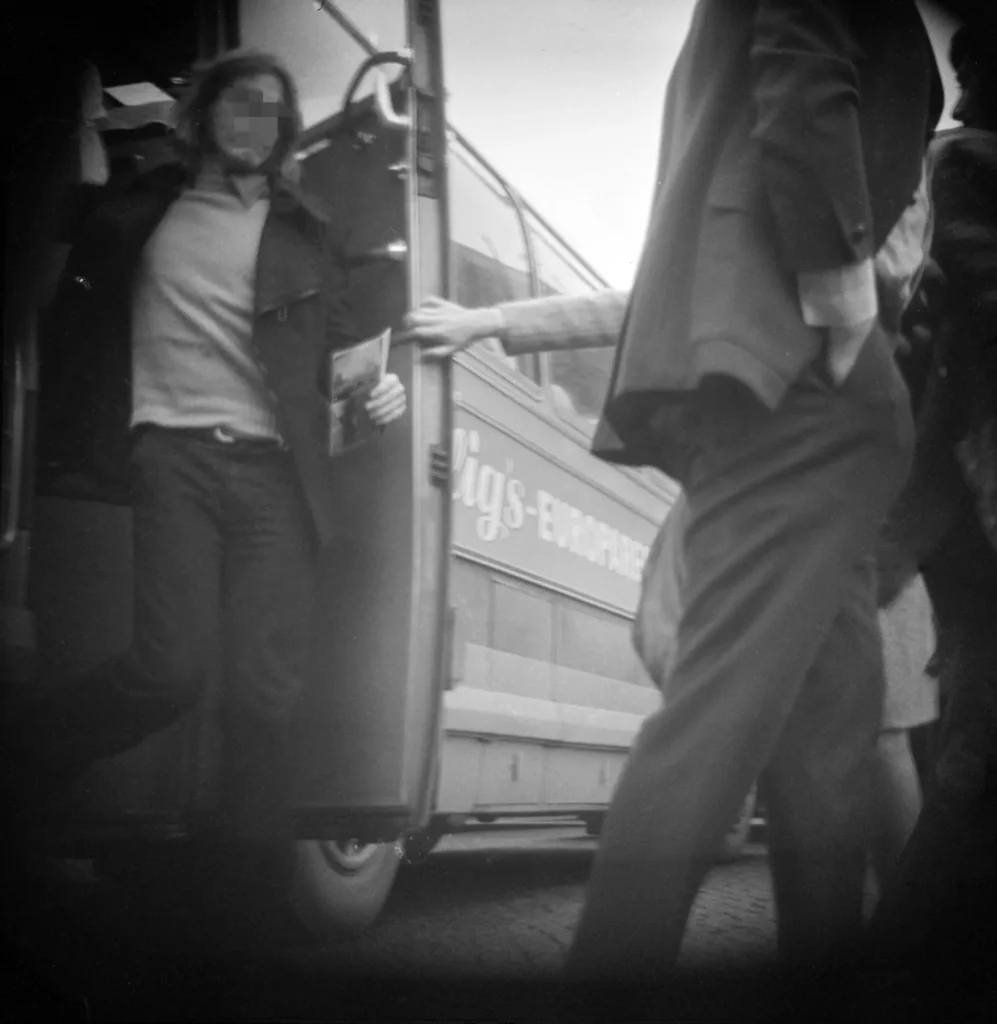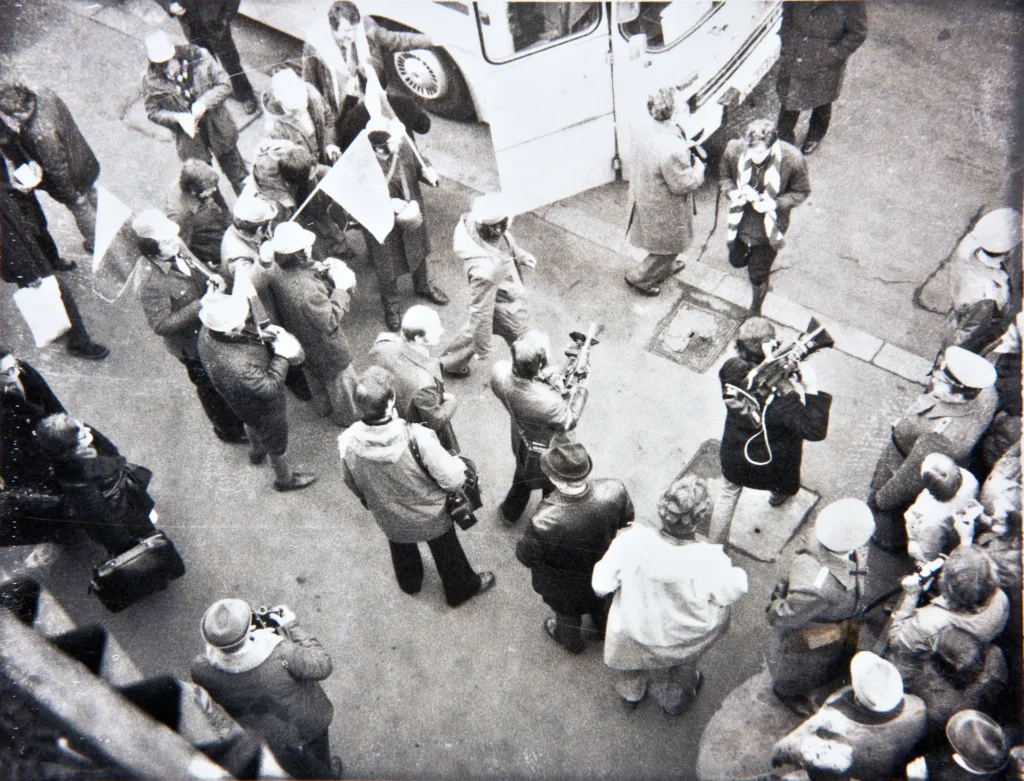Photo reconnaissance groups were embedded in the criminal investigation departments of the DVP’s district authorities. Their tasks included observing and monitoring spectators and football fans. Every week, the police photographers provided the Ministry for State Security (MfS) with documentation that was used for more than just ensuring order and security. SED officials viewed a burgeoning kind of fan culture as a ‘glorification’ of the Western way of life. Fans formed their own fan clubs and were rebellious, provocative and sometimes violent.
They sang songs and shared materials that state leadership considered “negatively decadent”. In response, the SED cast a broad surveillance net over football in the GDR. A “high-security matches” catalogue indicated which matches were considered dangerous. On the list: GDR Oberliga league matches involving clubs with violent fan groups, derbies in East Berlin and Leipzig, the FDGB Cup final (Freier Deutscher Gewerkschaftsbund, or Free German Trade Union Federation) matches involving Dynamo and Vorwärts (unpopular teams associated with the “protection and security organs”) as well as appearances by Bundesliga (i.e. West German) teams in the GDR and Eastern Europe. Inside the stadiums, security force photographers wore their uniforms or plainclothes. But outside, they operated more covertly and even used hidden cameras. The MfS had most of this clandestine photographic work carried out by both trained specialists and so-called Unofficial Collaborators (Inoffizielle Mitarbeiter, or IMs).
This Soviet F-21 miniature camera with a button attachment was usually used on jackets with sewn-on pockets. The jacket button was removed and firmly attached to the camera lens. The ‘button lens’ was then passed through a slit in the jacket to the outside. (4)
A ‘prepared’ camera: The MfS used cameras for undercover work that allowed them to take photos secretly. This flat 35mm ‘Tessina’ camera could be hidden in a purse. It took photos via holes drilled in the side compartment and was ideal for use when in close proximity to a target. (5)
It’s not just the football that gets moving on match day. Photojournalists were present inside the stadium, shown here at Friedrich Ludwig Jahn Sport Park in East Berlin and Dr. Kurt Fischer Stadium in Karl-Marx-Stadt (literally Karl Marx City, known both before and after the GDR as Chemnitz) in the 1980s. They captured the action on the field, as well as the atmosphere in the stadium. Photographers from the People’s Police and the MfS also posed as photojournalists, but they were only interested in the spectators in the stands. (6, 7, 8)
People’s Police officers analysing photographs in 1983. (10)
A People’s Police photographer secretly photographed FC Bayern Munich supporters arriving at Magdeburg Central Station from a higher building in autumn 1974. The Bayern fans boarded a waiting bus to travel to the European Champions Cup round of 16 match between 1. FC Magdeburg and FC Bayern Munich. (11)
MfS photographers secretly photographed FC Bayern Munich fans in the centre of Dresden using ‘prepared’ cameras. The MfS were keeping tabs on the Bayern supporters in the run-up to the European Cup round of 16 match between Dynamo Dresden and FC Bayern in autumn 1973. (12)
A covert photo taken by the MfS in Dresden city centre in autumn 1979: The focus is on fans from East and West prior to the UEFA Cup match between Dynamo Dresden and VfB Stuttgart. The reflection on the image indicates that the camera was probably positioned behind a window. (13)
1: Polizeihistorische Sammlung Berlin
2: Bundesarchiv, MfS BV Bln Fo 383 Bild 2
3: Landesarchiv Berlin, DVP BV Berlin, C Rep. 303 Nr. 3082
4: Sammlung Stasimuseum Berlin/Foto John Steer
5: Sammlung Stasimuseum Berlin/Foto John Steer
6: Bundesarchiv, MfS BV Bln Fo 847 Bild 15
7: Bundesarchiv, MfS HA XX Fo 1790 Bild 27
8: Bundesarchiv, MfS BV Kmst KD Kst 162
9: Bundesarchiv, MfS BV Ddn Abt. VIII Nr. 12535 Bild 252
10: Polizeihistorische Sammlung Berlin
11: Landesarchiv Sachsen-Anhalt, Bezirksbehörde der Deutschen Volkspolizei M24 Nr. 584 Foto 27
12: Bundesarchiv, MfS BV Ddn Abt. VIII Nr. 12535 Bild 185
13: Bundesarchiv, MfS BV Ddn Abt. VIII Nr. 11287 Bd. 3 Bild 122
14: Bundesarchiv, MfS BV Bln Fo 383 Bild 5










